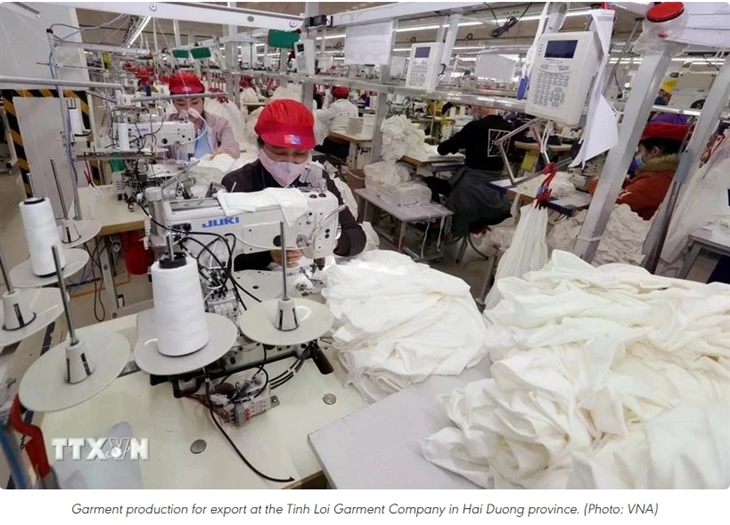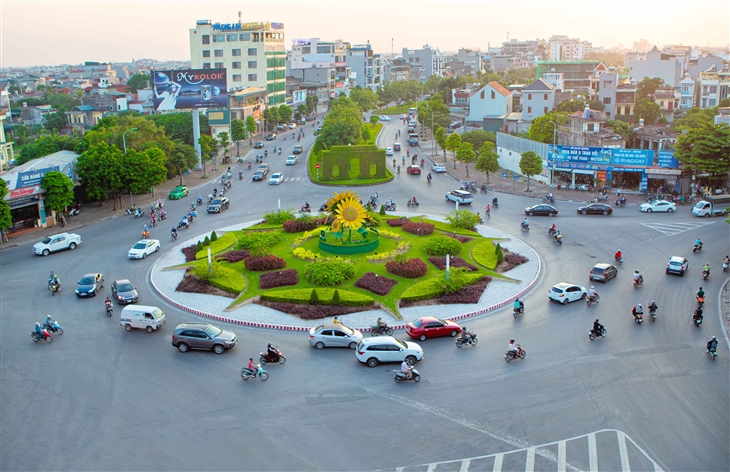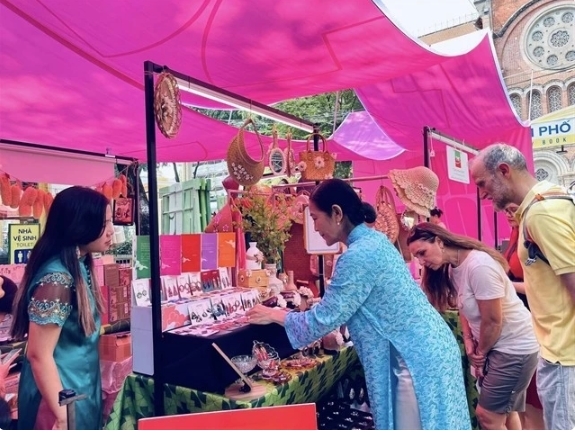US reciprocal tariffs spark supply chain concerns
Wednesday, April 9,2025
AsemconnectVietnam - A leader of the Vietnam Leather, Footwear and Handbag Association (Lefaso) highlighted that a 46% tariff would severely affect an industry employing over 1.2 million workers, 90% of whom are women.
Vietnam’s key export industries have voiced concerns over the US administration’s announcement of a 46% reciprocal tariff, with experts warning of serious repercussions on global supply chains and bilateral trade ties.
Worries about supply chain disruption
Calling the new tariff “a major shock”, Ngo Sy Hoai, Vice Chairman and General Secretary of the Vietnam Timber and Forest Product Association (Viforest), stressed that Vietnamese wood exports do not directly compete with US manufacturers in the US market, they neither threaten the US industry nor affect this North American country's national security. The two sides' wood trading structures are complementary to each other.
Vietnam has become the world’s second-largest consumer of US round and sawn timber, after China, Hoai noted, stressing that many materials imported from the US such as oak, ash, beech, and maple are transformed by Vietnamese workers into refined furniture and then re-exported to the US market.
This sector was built on a foundation of mutual benefit. A 46% tariff would be a devastating blow, he said. To address the trade imbalance, Viforest is actively promoting US wood in Vietnam and increasing imports from American suppliers.
Do Thi Thuy Huong, a representative of the Vietnam Electronic Industries Association, warned the new tariff could drive up operational costs, squeezing Vietnamese manufacturers out of the competition with producers in lower-tariff nations like the UK, Brazil, the Republic of Korea, and Japan.
The proposed tariff is unreasonably high, especially considering that Vietnam does not impose similar duties on US goods, Huong said, adding the association is mobilising support across key industries to form a united voice in policy advocacy.
Vice President and General Secretary of the Vietnam Leather, Footwear and Handbag Association (Lefaso) Phan Thi Thanh Xuan highlighted that a 46% tariff would severely affect an industry employing over 1.2 million workers, 90% of whom are women. Vietnam could see orders shift to rivals like Indonesia and India if the tariff is imposed.
Not Rivals, But Partners
During a meeting on April 4 with representatives from US businesses and associations, including AmCham and the US-ASEAN Business Council, Deputy Prime Minister Ho Duc Phoc underscored that Vietnamese and US goods are not in competition, but rather serve complementary market needs.
According to Vietnam Customs, the country’s exports to the US totalled 119.5 billion USD in 2024. Electronics led the way with 23.2 billion USD, accounting for 19.41%. They were followed by machinery, equipment, tools, and spare parts 18.45%, and textiles - garments 13.52%. Meanwhile, Vietnam remains a major destination for high-tech US investments, particularly in semiconductors and microchips, which are important to global supply chains of US companies.
Vietnam’s agricultural exports such as seafood, coffee, pepper, and wooden furniture are also crucial to meeting US consumers' demand, said Hoang Thi Lien, Chairwoman of the Vietnam Pepper and Spice Association. Even a 10% tax would be a burden, 46% is too high.
Minister of Agriculture and Environment Do Duc Duy echoed the view, emphasising that Vietnamese agricultural goods are high quality, reasonably priced, and pose no threat to American industries. Any disruption, he warned, will hurt both economies and directly impact US consumers.
Dr. Nguyen Si Dung, former Vice Chairman of the National Assembly Office, cautioned that such a tariff will not only harm Vietnamese firms but also jeopardise the US’s own supply chains, especially those relocated to Vietnam after years of restructuring. US consumers will also face higher goods prices./.
Source: en.vietnamplus.vn/us-reciprocal-tariffs-spark-supply-chain-concerns-post313025.vnp
Worries about supply chain disruption
Calling the new tariff “a major shock”, Ngo Sy Hoai, Vice Chairman and General Secretary of the Vietnam Timber and Forest Product Association (Viforest), stressed that Vietnamese wood exports do not directly compete with US manufacturers in the US market, they neither threaten the US industry nor affect this North American country's national security. The two sides' wood trading structures are complementary to each other.
Vietnam has become the world’s second-largest consumer of US round and sawn timber, after China, Hoai noted, stressing that many materials imported from the US such as oak, ash, beech, and maple are transformed by Vietnamese workers into refined furniture and then re-exported to the US market.
This sector was built on a foundation of mutual benefit. A 46% tariff would be a devastating blow, he said. To address the trade imbalance, Viforest is actively promoting US wood in Vietnam and increasing imports from American suppliers.
Do Thi Thuy Huong, a representative of the Vietnam Electronic Industries Association, warned the new tariff could drive up operational costs, squeezing Vietnamese manufacturers out of the competition with producers in lower-tariff nations like the UK, Brazil, the Republic of Korea, and Japan.
The proposed tariff is unreasonably high, especially considering that Vietnam does not impose similar duties on US goods, Huong said, adding the association is mobilising support across key industries to form a united voice in policy advocacy.
Vice President and General Secretary of the Vietnam Leather, Footwear and Handbag Association (Lefaso) Phan Thi Thanh Xuan highlighted that a 46% tariff would severely affect an industry employing over 1.2 million workers, 90% of whom are women. Vietnam could see orders shift to rivals like Indonesia and India if the tariff is imposed.
Not Rivals, But Partners
During a meeting on April 4 with representatives from US businesses and associations, including AmCham and the US-ASEAN Business Council, Deputy Prime Minister Ho Duc Phoc underscored that Vietnamese and US goods are not in competition, but rather serve complementary market needs.
According to Vietnam Customs, the country’s exports to the US totalled 119.5 billion USD in 2024. Electronics led the way with 23.2 billion USD, accounting for 19.41%. They were followed by machinery, equipment, tools, and spare parts 18.45%, and textiles - garments 13.52%. Meanwhile, Vietnam remains a major destination for high-tech US investments, particularly in semiconductors and microchips, which are important to global supply chains of US companies.
Vietnam’s agricultural exports such as seafood, coffee, pepper, and wooden furniture are also crucial to meeting US consumers' demand, said Hoang Thi Lien, Chairwoman of the Vietnam Pepper and Spice Association. Even a 10% tax would be a burden, 46% is too high.
Minister of Agriculture and Environment Do Duc Duy echoed the view, emphasising that Vietnamese agricultural goods are high quality, reasonably priced, and pose no threat to American industries. Any disruption, he warned, will hurt both economies and directly impact US consumers.
Dr. Nguyen Si Dung, former Vice Chairman of the National Assembly Office, cautioned that such a tariff will not only harm Vietnamese firms but also jeopardise the US’s own supply chains, especially those relocated to Vietnam after years of restructuring. US consumers will also face higher goods prices./.
Source: en.vietnamplus.vn/us-reciprocal-tariffs-spark-supply-chain-concerns-post313025.vnp
Businesses need to respond flexibly to minimise impact of US new tariffs: insiders
Vietnam, Laos boost trade at Savannakhet expo
Vietnam – a destination for world leaders amid global trade tensions: Argentina newspaper
Construction begins on Vietnam – China cross-border bridge
Many solutions to promote seafood exports to Norway
Tien Giang: Rice exports to the Philippines explode, increasing by nearly 100%
List of commodities with preferential import tax reduction
Japanese rice prices increase 'shockingly', does Vietnamese rice have a chance?
In the first quarter of 2025, agricultural, forestry and fishery exports reached 15.72 billion USD
What do Vietnamese and Brazilian enterprises expect from the President's visit?
Repositioning fruit and vegetable export industry
Vinh Phuc eyes stronger trade, investment ties with Chinese locality
Vietnam - Singapore import-export turnover reached over 6.57 billion SGD
Vietnamese honey and seafood comply with EU residue control regulations

Plan of Hai Duong province for a period of 2021 - 2030, ...
Organize space reasonably and harmoniously, focusing on connecting Hai Duong in common development space, actively contributing to the ...Plan of Hau Giang province in a period of 2021 - 2030, ...
Sustainable forestry development program in a period of ...

Art programme honouring Ao dai opens at HCM City Book ...
An art programme to honour and promote traditional cultural values and the beauty and grace of Ao dai has opened in Ho Chi Minh City. It ...From Hanoi to Brussels – a cross-cultural musical journey
Talented youngsters to enjoy int'l football ...
Tien Linh, Thuy Trang win Vietnam Golden Ball 2024
HCM City’s ao dai festival to feature mass folk dance with ...



